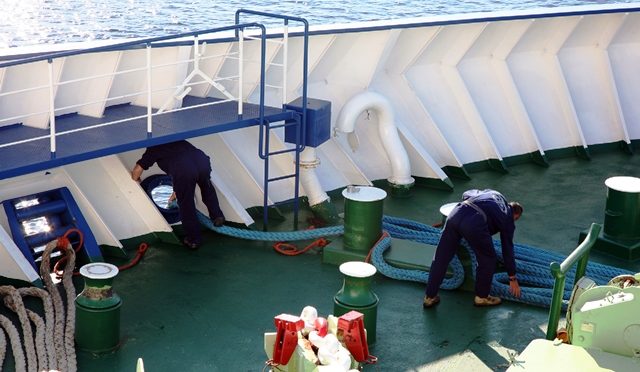The Nautical Institute has issued Mars Report regarding an incident in which the deck officer onboard a large LNG carrier was found lying unconscious due to snap-back slipup. NI provides lessons learned of the accident to highlight the hazards of Snap-backs
The Incident
A large LNG carrier was being warped into position by tensioning the forward back springs. The deck officer in charge of the forward mooring party was standing aft of the fairlead through which the spring lines passed. He was directing operations by signalling to a seaman who was located forward. From this position the seaman was able to relay the signals to the winch operator, who could not see the deck officer. While under tension, the mooring line parted inboard from a pedestal fairlead. The section of the line between the break and the port shoulder roller fairlead struck the deck officer on the head as it whipped back before going overboard through the fairlead. The deck officer was found lying unconscious forward of the roller fairlead. He had sustained multiple skull fractures. The mooring line that failed was a 44-millimetre-diameter sheathed ultra-high-modulus polyethylene line. The line was fitted with a 22-metre-long polyester/polyethylene tail. The section of line in use between the winch and the connection with the tail was approximately 68 metres long.
Lessons learned
- Snap-back zones can be complex and sometimes counter-intuitive. In this case, computer modelling was used after the accident to assess the dynamic trajectory of the entire length of the rope from its point of failure. The modelling indicated that it was highly probable that the rope would go aft of the roller fairlead and wrap around it before finally going outboard.
- Synthetic tails provide additional elasticity in the mooring system and serve to reduce peak dynamic loads. As a result of the tail’s elasticity, the elongation of the total mooring line under tension is increased; this introduces considerable stored energy that will be released if the mooring line fails. The snap-back characteristics of this type of mooring line (ultra-high-modulus polyethylene), initially considered to be relatively benign, will be heavily influenced by the addition of the synthetic tail.
- The length of tail fitted to the mooring line will influence the amount of stored energy in the system. The longer the tail, the greater the elasticity and stored energy, and the greater the likelihood of recoil and snap-back should the mooring line fail.
- Depending on where the line breaks, there can be snap-back zones in multiple locations. Actual mooring arrangements on board require specific analysis to determine the most likely snap-back zones.
- The best protection during mooring operations is not to have line ruptures. Careful inspection, use and well-considered modifications, such as adding synthetic tails, are the best guarantee of safe operation.
Snap back is the most common factor for injuries and fatalities during mooring lines failures. As most of the lines are synthetic (made of polypropylene, Polyethylene, Polyester, Nylon or mixed materials), the elasticity hazard is always present when handling ropes.
All mooring lines under tension will stretch, particularly those made from synthetic material. Should the line break, stored energy will be released as it reverts to its original length. The two ends of the line will recoil or “snap-back” towards and past the points to which they are secured. Anyone standing within the snap-back zone at either end of the line risks serious injury or death.
When a synthetic mooring line breaks, the snap-back effect can be extremely powerful and the rope ends may reach a velocity of up to more than 500 km/h as they recoil. The possible area of the snap-back zone of the rope when it recoils will increase in breadth the further it travels from the point of breakage. The end of the broken rope may also recoil past the point to which it is secured to a distance almost equal to the remaining length.
Industry stakeholders (Flags, ROs, P&I clubs, Associations etc) have developed various instructions and best practices to address item. All related recommendations should be taken into consideration during mooring/ un mooring / tug handling operation.
Also please click below to read OCIMF’s Guide on The Hazards of Snap-Back

































































Much appreciate the article wrt the dangers of the snap-back when a rope parts and highlighting the serious consequences. Yes agree that the there should be a proper awareness of the problems and should be discussed on-board by those involved in the mooring operations. The UK’s CHIRP recommends that the earlier suggestion of marking the snap-back zone is not the correct way to deal with it, since the mooring arrangements and leads could differ during different operations. Hence raising the awareness and being alert and cautious is the best option.
I totally agree, marking of certain areas only creates a false sense of safety, on my vessel the entire foc’sle is regarded as a “snap back zone” aft deck a bit more complicated to demarcate as it’s a Dive Support Vessel with mooring winches, tugger winch and a waterfall double drum winch.